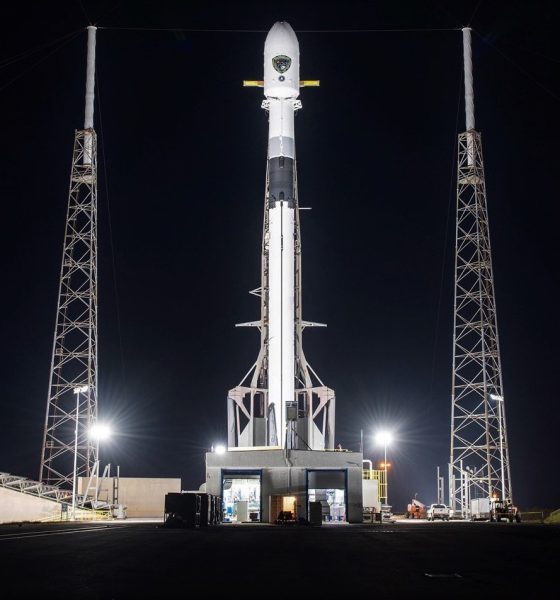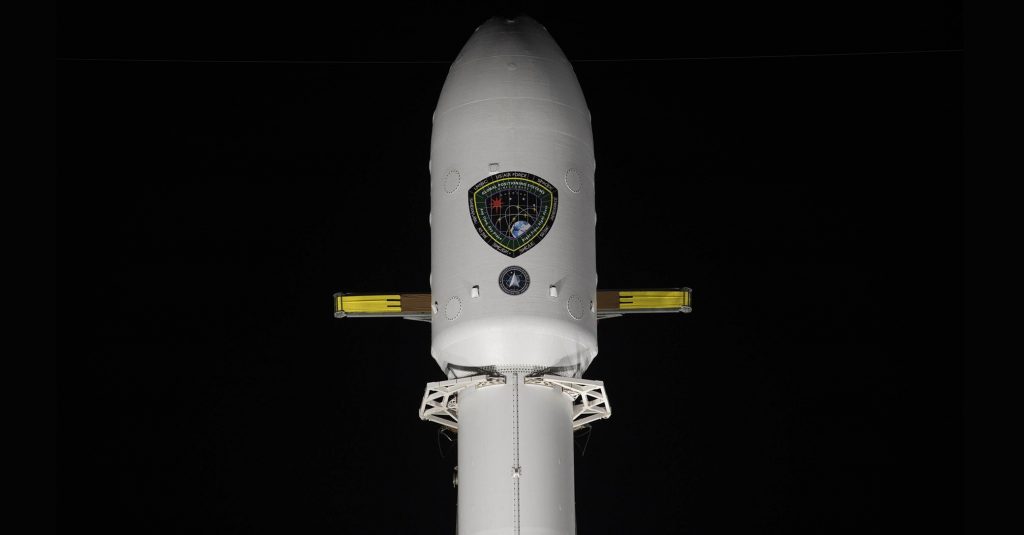

News
SpaceX set for rocket recovery first after US military satellite launch
A SpaceX Falcon 9 is set to become the first commercial rocket to attempt to land after an operational launch for the US military, potentially paving the way for an even more significant milestone somewhere down the road.
Featuring brand new booster B1060 and a new upper stage and payload fairing, Falcon 9 is scheduled to launch the US military’s third upgraded GPS III satellite (PS III SV01) no earlier than (NET) 3:55 pm EDT (19:55 UTC) on June 30th. While it will be the second time a Falcon 9 Block 5 rocket has lifted off from Cape Canaveral Air Force Station (CCAFS) Launch Complex 40 (LC-40) with a GPS III satellite in tow, the mission will mark a critical first for SpaceX and the US military. For the first GPS III mission, the US Air Force somewhat inexplicably required SpaceX to expend the new Falcon 9 booster assigned to the December 2018 launch.
The US military never offered a technical explanation for why Falcon 9 couldn’t land after launching a ~3900 kg (~8600 lb) GPS III SV01 to a medium orbit but could, for example, land after launching a dozen metric tons and two NASA astronauts. Regardless, the US Air Force Space and Missile Systems Command (SMC) has decided that SpaceX can now attempt to land Falcon 9’s first stage during the company’s second GPS III launch. A step further, on the eve of the mission, SMC has revealed that it may even be opening up to the idea of reusing SpaceX boosters on future military launches.

Falcon 9 B1060 has a 15-minute window to launch the GPS III SV03 spacecraft on Tuesday, June 30th. Meanwhile, drone ship Just Read The Instructions (JRTI) – heading out to sea to prepare for B1060’s attempted landing – recently passed just a few miles from drone ship Of Course I Still Love You (OCISLY) – returning to Port Canaveral after SpaceX decided to delay its ninth Starlink v1.0 launch from June 23rd. 25th, and 26th to the first or second week of July.
JRTI arrived at its post ~630 km (~390 mi) East of the Florida Coast on June 29th, around 36 hours before liftoff.
Drone ship JRTI was recently recommissioned after extensive upgrades and a several thousand mile move from Port of Los Angeles, California to Port Canaveral, Florida, ultimately supporting its first East Coast booster landing and recovery barely three weeks ago. If successful, B1060 will become the first orbital-class booster ever to land after an operational US military launch, excluding a number of Space Shuttle missions in the 1980s.

According to reporting by Space News’ Sandra Erwin, it’s unlikely that SpaceX will reserve Falcon 9 booster B1060 – assuming a successful landing – for reuse on a future US military launch. Given that SMC appears to have even stricter requirements than NASA’s Commercial Crew (CCP) and Commercial Resupply Services (CRS) programs, it’s safe to assume that – like NASA – the US military will only initially allow booster reuse if said booster has only flown missions for the agency. Given that Falcon 9’s next known US military launch (GPS III SV04) is NET “late 2020” and that there “are currently no plans to use a previously-flown booster on any future GPS launches”, it’s unlikely that SpaceX will waste a perfectly good booster by saving it for 6-18+ months.
Regardless, as usual, SpaceX will host an uninterrupted webcast of the launch. Tune in around 15 minutes prior to catch SpaceX’s third launch of the month and 11th of the year.
Check out Teslarati’s Marketplace! We offer Tesla accessories, including for the Tesla Cybertruck and Tesla Model 3.

Elon Musk
Elon Musk’s X will start using a Tesla-like software update strategy
The initiative seems designed to accelerate updates to the social media platform, while maintaining maximum transparency.

Elon Musk’s social media platform X will adopt a Tesla-esque approach to software updates for its algorithm.
The initiative seems designed to accelerate updates to the social media platform, while maintaining maximum transparency.
X’s updates to its updates
As per Musk in a post on X, the social media company will be making a new algorithm to determine what organic and advertising posts are recommended to users. These updates would then be repeated every four weeks.
“We will make the new 𝕏 algorithm, including all code used to determine what organic and advertising posts are recommended to users, open source in 7 days. This will be repeated every 4 weeks, with comprehensive developer notes, to help you understand what changed,” Musk wrote in his post.
The initiative somewhat mirrors Tesla’s over-the-air update model, where vehicle software is regularly refined and pushed to users with detailed release notes. This should allow users to better understand the details of X’s every update and foster a healthy feedback loop for the social media platform.
xAI and X
X, formerly Twitter, has been acquired by Elon Musk’s artificial intelligence startup, xAI last year. Since then, xAI has seen a rapid rise in valuation. Following the company’s the company’s upsized $20 billion Series E funding round, estimates now suggest that xAI is worth tens about $230 to $235 billion. That’s several times larger than Tesla when Elon Musk received his controversial 2018 CEO Performance Award.
As per xAI, the Series E funding round attracted a diverse group of investors, including Valor Equity Partners, Stepstone Group, Fidelity Management & Research Company, Qatar Investment Authority, MGX, and Baron Capital Group, among others. Strategic partners NVIDIA and Cisco Investments also continued support for building the world’s largest GPU clusters.
News
Tesla FSD Supervised wins MotorTrend’s Best Driver Assistance Award
The decision marks a notable reversal for the publication from prior years, with judges citing major real-world improvements that pushed Tesla’s latest FSD software ahead of every competing ADAS system.

Tesla’s Full Self-Driving (Supervised) system has been named the best driver-assistance technology on the market, earning top honors at the 2026 MotorTrend Best Tech Awards.
The decision marks a notable reversal for the publication from prior years, with judges citing major real-world improvements that pushed Tesla’s latest FSD software ahead of every competing ADAS system. And it wasn’t even close.
MotorTrend reverses course
MotorTrend awarded Tesla FSD (Supervised) its 2026 Best Tech Driver Assistance title after extensive testing of the latest v14 software. The publication acknowledged that it had previously criticized earlier versions of FSD for erratic behavior and near-miss incidents, ultimately favoring rivals such as GM’s Super Cruise in earlier evaluations.
According to MotorTrend, the newest iteration of FSD resolved many of those shortcomings. Testers said v14 showed far smoother behavior in complex urban scenarios, including unprotected left turns, traffic circles, emergency vehicles, and dense city streets. While the system still requires constant driver supervision, judges concluded that no other advanced driver-assistance system currently matches its breadth of capability.
Unlike rival systems that rely on combinations of cameras, radar, lidar, and mapped highways, Tesla’s FSD operates using a camera-only approach and is capable of driving on city streets, rural roads, and freeways. MotorTrend stated that pure utility, the ability to handle nearly all road types, ultimately separated FSD from competitors like Ford BlueCruise, GM Super Cruise, and BMW’s Highway Assistant.
High cost and high capability
MotorTrend also addressed FSD’s pricing, which remains significantly higher than rival systems. Tesla currently charges $8,000 for a one-time purchase or $99 per month for a subscription, compared with far lower upfront and subscription costs from other automakers. The publication noted that the premium is justified given FSD’s unmatched scope and continuous software evolution.
Safety remained a central focus of the evaluation. While testers reported collision-free operation over thousands of miles, they noted ongoing concerns around FSD’s configurable driving modes, including options that allow aggressive driving and speeds beyond posted limits. MotorTrend emphasized that, like all Level 2 systems, FSD still depends on a fully attentive human driver at all times.
Despite those caveats, the publication concluded that Tesla’s rapid software progress fundamentally reshaped the competitive landscape. For drivers seeking the most capable hands-on driver-assistance system available today, MotorTrend concluded Tesla FSD (Supervised) now stands alone at the top.
News
Elon Musk’s Grokipedia surges to 5.6M articles, almost 79% of English Wikipedia
The explosive growth marks a major milestone for the AI-powered online encyclopedia, which was launched by Elon Musk’s xAI just months ago.

Elon Musk’s Grokipedia has grown to an impressive 5,615,201 articles as of today, closing in on 79% of the English Wikipedia’s current total of 7,119,376 articles.
The explosive growth marks a major milestone for the AI-powered online encyclopedia, which was launched by Elon Musk’s xAI just months ago. Needless to say, it would only be a matter of time before Grokipedia exceeds English Wikipedia in sheer volume.
Grokipedia’s rapid growth
xAI’s vision for Grokipedia emphasizes neutrality, while Grok’s reasoning capabilities allow for fast drafting and fact-checking. When Elon Musk announced the initiative in late September 2025, he noted that Grokipedia would be an improvement to Wikipedia because it would be designed to avoid bias.
At the time, Musk noted that Grokipedia “is a necessary step towards the xAI goal of understanding the Universe.”
Grokipedia was launched in late October, and while xAI was careful to list it only as Version 0.1 at the time, the online encyclopedia immediately earned praise. Wikipedia co-founder Larry Sanger highlighted the project’s innovative approach, noting how it leverages AI to fill knowledge gaps and enable rapid updates. Netizens also observed how Grokipedia tends to present articles in a more objective manner compared to Wikipedia, which is edited by humans.
Elon Musk’s ambitious plans
With 5,615,201 total articles, Grokipedia has now grown to almost 79% of English Wikipedia’s article base. This is incredibly quick, though Grokipedia remains text-only for now. xAI, for its part, has now updated the online encyclopedia’s iteration to v0.2.
Elon Musk has shared bold ideas for Grokipedia, including sending a record of the entire knowledge base to space as part of xAI’s mission to preserve and expand human understanding. At some point, Musk stated that Grokipedia will be renamed to Encyclopedia Galactica, and it will be sent to the cosmos.
“When Grokipedia is good enough (long way to go), we will change the name to Encyclopedia Galactica. It will be an open source distillation of all knowledge, including audio, images and video. Join xAI to help build the sci-fi version of the Library of Alexandria!” Musk wrote, adding in a later post that “Copies will be etched in stone and sent to the Moon, Mars and beyond. This time, it will not be lost.”








